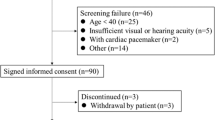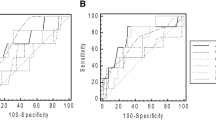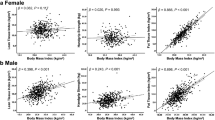Abstract
Background/objectives
Kidney dialysis patients with sarcopenia have increased mortality. Screening for low muscle mass may allow interventions at an earlier stage to help improve outcomes. We wished to determine the prevalence of low muscle mass in a cohort of peritoneal dialysis (PD) patients.
Subjects/methods
We measured lean body mass index (LBMI) in 490 PD patients by bioimpedance, grading patients using two different classifications of sarcopenia.
Results:
LBMI was 9.7±1.9 kg/m2, mean age was 55.3±16.4 years, 53.1% were male, 33.7% were diabetic and 51% were Caucasoid. 98.5% of patients were classified as having sarcopenia based on LBMI cutoffs from NHANES data, whereas 28.8% had moderate and 6.3% severe sarcopenia using a grading correlated with functional disability. Lower muscle mass was associated with increasing co-morbidity (β=0.34, P=0.02) and age (β=0.01, P=0.006), and negatively with body mass index (β=−0.23, P<0.001), log serum creatinine (β=−0.231, P<0.001), normalised protein nitrogen appearance (β=−1.33, P<0.001) and log urine volume (β=−0.28, P=0.002). There was no association with duration of PD, dialysis prescription, residual renal function or solute clearances.
Conclusions:
There is currently no agreed universal definition for sarcopenia, and prevalence varied markedly depending on the scoring system. Prevalence was not associated with small solute clearances, but was associated with sex, age co-morbidity, BMI and ethnicity. There was an association with dietary protein intake and urine volume, which may allow for dietary interventions and strategies to preserve urine output to reduce muscle loss in PD patients.
This is a preview of subscription content, access via your institution
Access options
Subscribe to this journal
Receive 12 print issues and online access
$259.00 per year
only $21.58 per issue
Buy this article
- Purchase on Springer Link
- Instant access to full article PDF
Prices may be subject to local taxes which are calculated during checkout



Similar content being viewed by others
References
Griffiths RD . Muscle mass, survival, and the elderly ICU patient. Nutrition 1996; 12: 456–458.
Wang XH, Mitch WE . Mechanisms of muscle wasting in chronic kidney disease. Nat Rev Nephrol 2014; 10: 504–516.
Rajakaruna G, Caplin B, Davenport A . Peritoneal protein clearance rather than faster transport status determines outcomes in peritoneal dialysis patients. Perit Dial Int 2015; 35: 216–221.
Fahal IH . Uraemic sarcopenia: aetiology and implications. Nephrol Dial Transplant 2014; 29: 1655–1665.
Cigarrán S, Pousa M, Castro MJ, González B, Martínez A, Barril G et al. Endogenous testosterone, muscle strength, and fat-free mass in men with chronic kidney disease. J Ren Nutr 2013; 23: e89–e95.
Davenport A, King RF, Ironside JW, Will EJ, Davison AM . The effect of treatment with recombinant human erythropoietin on the histological appearance and glycogen content of skeletal muscle in patients with chronic renal failure treated by regular hospital haemodialysis. Nephron 1993; 64: 89–94.
Cruz-Jentoft AJ, Baeyens JP, Bauer JM, Boirie Y, Cederholm T, Landi F et al. European Working Group on Sarcopenia in Older People. Sarcopenia: European consensus on definition and diagnosis: Report of the European Working Group on Sarcopenia in Older People. Age Ageing 2010; 39: 412–423.
Reid J, Noble H, Davenport A, Farrington K, Fouque D, Porter S et al. Defining cachexia in a renal population. J Ren Care 2015; 41: 79–80.
Baumgartner RN, Koehler KM, Gallagher D, Romero L, Heymsfield SB, Ross RR et al. Epidemiology of sarcopenia among the elderly in New Mexico. Am J Epidemiol 1998; 147: 755–763.
Muscaritoli M, Anker SD, Argilés J, Aversa Z, Bauer JM, Biolo G et al. Consensus definition of sarcopenia, cachexia and pre-cachexia: joint document elaborated by Special Interest Groups (SIG) “cachexia-anorexia in chronic wasting diseases" and "nutrition in geriatrics". Clin Nutr 2010; 29: 154–159.
Kyle UG, Schutz Y, Dupertuis YM, Pichard C . Body composition interpretation. Contributions of the fat-free mass index and the body fat mass index. Nutrition 2003; 19: 597–604.
Fürstenberg A, Davenport A . Comparison of multifrequency bioelectrical impedance analysis and dual-energy X-ray absorptiometry assessments in outpatient haemodialysis patients. Am J Kidney Dis 2010; 57: 123–129.
Fürstenberg A, Davenport A . Assessment of body composition in peritoneal dialysis patients using bioelectrical impedance and dual-energy x-ray absorptiometry. Am J Nephrol 2011; 33: 150–156.
Kelly TL, Wilson KE, Heymsfield SB . Dual energy X-ray absorptiometry body composition reference values from NHANES. PLoS One 2009; 4: e7038.
Janssen I, Baumgartner RN, Ross R, Rosenberg IH, Roubenoff R . Skeletal muscle cutpoints associated with elevated physical disability risk in older men and women. Am J Epidemiol 2004; 159: 413–421.
McCafferty K, Fan S, Davenport A . Extracellular volume expansion, measured by multifrequency bioimpedance, does not help preserve residual renal function in peritoneal dialysis patients. Kidney Int 2014; 85: 151–157.
Davenport A . Does peritoneal dialysate affect body composition assessments using multi-frequency bioimpedance in peritoneal dialysis patients? Eur J Clin Nutr 2013; 67: 223–225.
Davenport A, Argawal B, Wright G, Mantzoukis K, Dimitrova R, Davar J et al. Can non-invasive measurements aid clinical assessment of volume in patients with cirrhosis? World J Hepatol 2013; 5: 433–438.
NKF-K/DOQI Clinical practice guidelines for peritoneal dialysis adequacy: Clinical practice recommendations for peritoneal dialysis adequacy. Am J Kid Dis 2006; 48: S98–S158.
Randerson DH, Chapman GV, Farell PC . Amino acid and dietary status in CAPD patients Atkins RC, Farell PC, Thomson N Peritoneal Dialysis. Churchill-Livingstone: Edinburgh, Scotland, 1981; 180–191.
Davies SJ, Phillips L, Naish PF, Russell GI . Quantifying comorbidity in peritoneal dialysis patients and its relationship to other predictors of survival. Nephrol Dial Transplant 2002; 17: 1085–1092.
Carrero JJ, Chmielewski M, Axelsson J, Snaedal S, Heimbürger O, Bárány P et al. Muscle atrophy, inflammation and clinical outcome in incident and prevalent dialysis patients. Clin Nutr 2008; 27: 557–564.
Lamarca F, Carrero JJ, Rodrigues JC, Bigogno FG, Fetter RL, Avesani CM . Prevalence of sarcopenia in elderly maintenance haemodialysis patients: the impact of different diagnostic criteria. J Nutr Health Aging 2014; 18: 710–717.
Davenport A, Willicombe M . Comparison of fluid status in patients treated by different modalities of peritoneal dialysis using multi-frequency bioimpedance. Int J Artif Organs 2009; 32: 779–786.
Davenport A . Effect of intra-abdominal dialysate on bioimpedance-derived fluid volume status and body composition measurements in peritoneal dialysis patients. Perit Dial Int 2013; 33: 578–579.
Panorchan K, Nongnuch A, El-Kateb S, Goodlad C, Davenport A . Changes in muscle and fat mass with haemodialysis detected by multi-frequency bioelectrical impedance analysis. Eur J Clin Nutr 2015; 69: 1109–1112.
Patel HP, Syddall HE, Jameson K, Robinson S, Denison H, Roberts HC et al. Prevalence of sarcopenia in community-dwelling older people in the UK using the European Working Group on Sarcopenia in Older People (EWGSOP) definition: findings from the Hertfordshire Cohort Study (HCS). Age Ageing 2013; 42: 378–384.
Batsis JA, Barre LK, Mackenzie TA, Pratt SI, Lopez-Jimenez F, Bartels SJ . Variation in the prevalence of sarcopenia and sarcopenic obesity in older adults associated with different research definitions: dual-energy X-ray absorptiometry data from the National Health and Nutrition Examination Survey 1999–2004. J Am Geriatr Soc 2013; 61: 974–980.
Stenvinkel P, Carrero JJ, von Walden F, Ikizler TA, Nader GA . Muscle wasting in end-stage renal disease promulgates premature death: established, emerging and potential novel treatment strategies. Nephrol Dial Transplant 2015; 31: 1070–1077.
Yu S, Appleton S, Adams R, Chapman I, Wittert G, Visvanathan T et al. The impact of low muscle mass definition on the prevalence of sarcopenia in older Australians. Biomed Res Int 2014; 2014: 361790.
Davenport A, Hussain Sayed R, Fan S . The effect of racial origin on total body water volume in peritoneal dialysis patients. Clin J Am Soc Nephrol 2011; 6: 2492–2498.
Davenport A, Willicombe MK . Does diabetes mellitus predispose to increased fluid overload in peritoneal dialysis patients? Nephron Clin Pract 2010; 114: c60–c66.
Martinson M, Ikizler TA, Morrell G, Wei G, Almeida N, Marcus RL et al. Associations of body size and body composition with functional ability and quality of life in haemodialysis patients. Clin J Am Soc Nephrol 2014; 9: 1082–1090.
Floege J, Gillespie IA, Kronenberg F, Anker SD, Gioni I, Richards S et al. Development and validation of a predictive mortality risk score from a European haemodialysis cohort. Kidney Int 2015; 87: 996–1008.
Isoyama N, Qureshi AR, Avesani CM, Lindholm B, Bàràny P, Heimbürger O et al. Comparative associations of muscle mass and muscle strength with mortality in dialysis patients. Clin J Am Soc Nephrol 2014; 9: 1720–1728.
Demirci MS, Demirci C, Ozdogan O, Kircelli F, Akcicek F, Basci A et al. Relations between malnutrition-inflammation-atherosclerosis and volume status. The usefulness of bioimpedance analysis in peritoneal dialysis patients. Nephrol Dial Transplant 2011; 26: 1708–1716.
Booth J, Pinney J, Davenport A . N-terminal proBNP–marker of cardiac dysfunction, fluid overload, or malnutrition in haemodialysis patients? Clin J Am Soc Nephrol 2010; 5: 1036–1040.
John B, Tan BK, Dainty S, Spanel P, Smith D, Davies SJ . Plasma volume, albumin, and fluid status in peritoneal dialysis patients. Clin J Am Soc Nephrol 2010; 5: 1463–1470.
Fan S, Sayed RH, Davenport A . Extracellular volume expansion in peritoneal dialysis patients. Int J Artif Organs 2012; 35: 338–345.
Daugirdas JT . Kt/V (and especially its modifications) remains a useful measure of haemodialysis dose. Kidney Int 2015; 88: 466–473.
Stenholm S, Harris TB, Rantanen T, Visser M, Kritchevsky SB, Ferrucci L . Sarcopenic obesity—definition, aetiology and consequences. Curr Opin Clin Nutr Metab Care 2008; 11: 693–700.
Dominguez LJ, Barbagallo M . The cardiometabolic syndrome and sarcopenic obesity in older persons. J Cardiometab Syndr 2007; 2: 183–189.
Davies SJ, Davenport A . The role of bioimpedance and biomarkers in helping to aid clinical decision-making of volume assessments in dialysis patients. Kidney Int 2014; 86: 489–496.
Author information
Authors and Affiliations
Corresponding authors
Ethics declarations
Competing interests
The authors declare no conflict of interest.
Additional information
Supplementary Information accompanies this paper on European Journal of Clinical Nutrition website
Supplementary information
Rights and permissions
About this article
Cite this article
Greenhall, G., Davenport, A. Screening for muscle loss in patients established on peritoneal dialysis using bioimpedance. Eur J Clin Nutr 71, 70–75 (2017). https://doi.org/10.1038/ejcn.2016.202
Received:
Revised:
Accepted:
Published:
Issue Date:
DOI: https://doi.org/10.1038/ejcn.2016.202
This article is cited by
-
Low muscle mass and early hospital readmission post-kidney transplantation
International Urology and Nephrology (2022)
-
Gender-specific associations of skeletal muscle mass and arterial stiffness among peritoneal dialysis patients
Scientific Reports (2018)



